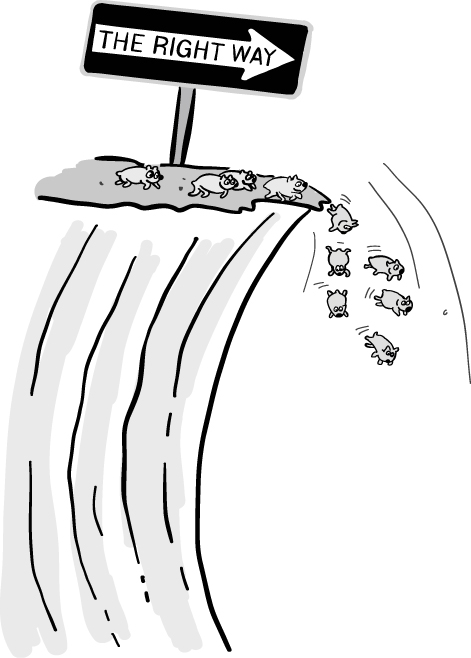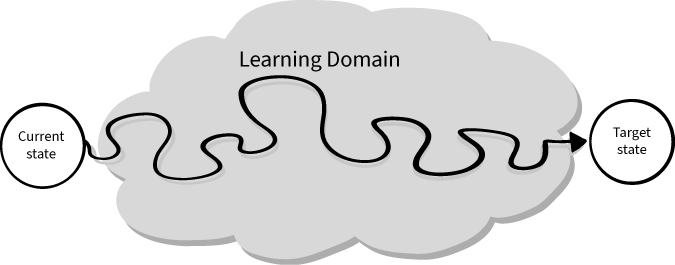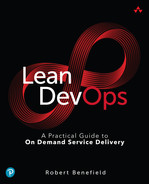Chapter 7
Learning
Learning is not compulsory… neither is survival.
W. Edwards Deming
In 2006, product design guru Peter Skillman gave a TED talk about some surprising discoveries he made in his design and learning experiments. In them he challenged people to work in teams for 18 minutes to build the tallest structure they could using only spaghetti, marshmallows, tape, and string. Astonishingly, he found kindergarten-aged children consistently scored better than everyone else. Even more interestingly, business school graduates somehow always fared the worst.
Why is this?
The secret lies in the difference in how each approached the challenge. Adults start by organizing themselves into roles and build a plan of action. We do this because our traditional education and business management systems have trained us to look at ways to divide up tasks aligned to a centrally coordinated plan. Having clear roles and assigned sets of responsibilities for everyone feels more organized and more efficient.
This structured approach fits well with many of the management ideals that came from the days of mass production, when tasks were known and there was low variation in work. Its problems become more apparent when trying to solve new challenges, whether building a tower out of food or delivering complex IT services. It ignores the fact that we rarely know enough about the problem we are trying to solve and the ecosystem it lives in to build a workable plan and optimize work up front. Not only is all the time and effort spent on organization and optimization wasteful, but it can actually slow down what progress is made through unnecessary fragmentation, missteps, and rework. Worst of all, it also hinders our ability to learn and adapt.
Kindergarteners do not have these problems for the simple reason that they haven’t been taught any of it yet. Instead, they plunge straight in with a target rather than a plan. Unlike us adults, they aren’t hindered with the “right” way of doing things. Instead, they simply try things and quickly learn what does and doesn’t work. With no plan or sacred cows in the way, they can toss away dead-end ideas and incorporate shared discoveries more quickly. Through this, they collectively hone and improve upon the knowledge they gain, then deploy it more effectively than their fragmented elders can. This results in structures that are not just more creative but also better than those of the adults.
Breaking these entrained habits is extremely difficult. They are ingrained so deeply as to make the path to recovery seem nonintuitive if not just wrong. To understand why they came to be, it is best to start with understanding their seemingly innocuous origins. Only then can we once again learn how to learn.
The Emergence of Skills Attainment Learning

Figure 7.1
The rise of public education.
We are born with an innate ability to learn. We look at, touch, taste, listen to, and try out various things to understand the properties of the world around us and how items behave within it. The challenge with learning is that without structure it can lead to intellectual drift and meandering into dead ends that can slow the improvement process and lead to inconsistent skills and knowledge across the team and population.
To bring consistency and structure to the learning process, educators from the 19th century until today have been encouraged to develop and hone an education model focused on building a collection of knowledge and skills that, like a toolbox full of tools, can be employed to solve a given problem. Students would then demonstrate what they learned through a series of graded assessments.
This model has been compelling for both governments and employers alike. Governments can assure citizenry had both foundational literacy and numeracy skills needed for tradesmen and professionals at all levels, as well as gain a sense of community and civic responsibility through civics and history lessons. Employers gain access to a skilled workforce that is likely to need less training and be more productive sooner.
Having a useful set of skills is undeniably a good thing. It is hard to imagine being able to work as a developer or DBA without some previous knowledge of the subject. However, determining a person’s mastery level at a given skill can be difficult to gauge if the mechanisms used to assess those skills vary from educator to educator. While standalone assessments can help a teacher find any gaps individual students may have, they do not provide much insight into how well the student performs against their peers in other classes or schools. This lack of insight makes it difficult for employers to easily gauge someone’s suitability for a job and hinders government officials from having a good way to measure the effectiveness of schools and educators.
To solve this, organizations from schools and universities, along with the authorities who support them, to businesses desiring to know the skills of prospective employees have turned to having students take the same standardized tests. While the idea is sound, it is also where the bad habits begin.
The Rise of the One Right Way

Figure 7.2
Some insist there is only one right way regardless of the consequences.
The first problem that standardized testing posed was the creation of the tests themselves. Determining someone’s knowledge level is difficult if questions are answered in vastly different ways. To make grading easier and limit debate, tests intentionally limit the number of answers and approaches considered acceptable to receive full marks.
This decision has had a number of unintended consequences.
The first of these is that it incentivizes teachers to “teach the test.” Knowing that their professional success will be assessed on their students’ test scores, they have little incentive to allow anything that does not closely adhere to the narrow set of acceptable answers and approaches.
Teaching to the test favors covering particular testing tricks over ensuring a firm understanding of the subject being taught. Even when teaching the subject, educators can find themselves bound to teaching particular methods that might be less conducive for helping students grasp key underlying concepts, all to keep students aligned to preferred exam approaches. Not only can this cause students to struggle, but by neglecting to develop an understanding of the underlying concepts, students might begin to find the topic, and ultimately schooling, pointless and tune out.
Another consequence of teaching to the test is that students become trained to believe that there is only one right approach for everything, and that following it will always lead to success. This encourages rule following over innovating to improve beyond the status quo. People become entrained to use whatever “best practices,” tools, and technologies they have been told are the right ones to use rather than finding the ones that in their ecosystem are more effective at helping them achieve the desired outcome. Many will even go so far as to prevent others from seeking out to make improvements solely on the grounds that they are not the “standard” or “best practice.” This often results in long-obsolete processes and technology lingering far beyond their usefulness.
Perhaps the most frustrating part of all of this is that it encourages people to focus on completing tasks and being assessed on how well they were performed rather than whether their efforts contributed to achieving the desired outcome. This limits the scope of what can actually be learned and improved, as failure can occur just as easily by choosing the wrong task to perform as performing the right task badly.
In order to correct this bias, organizations need to change the focus of learning and improvement from tasks and other localized measures to ones centered on the target outcome desired.
Outcome-Directed Learning
Another approach is what I call outcome-directed learning. The idea is that learning is guided by a stated desired outcome or set of conditions, with the learner exploring and experimenting to build knowledge and skills to eventually reach the desired outcome. This approach is at the core of continual improvement processes such as Lean. While practitioners rarely completely eschew skills attainment learning, the emphasis on the outcome moves the focus away from individual acts to the purpose of the activities.
There are a number of critical pieces to this approach that need to be in place for it to work effectively. The first is that it is not enough to simply state the outcome. The practitioner also needs to know the reasons why the outcome or condition is desired. This not only gives some purpose to the journey, but also can provide some clues to the best measures to use to know you are progressing toward the target outcome.
The next important element is for the practitioner to have a good idea of the current state. The current state is the reference point that you will ultimately be measuring from to determine whether any actions taken, knowledge acquired, or skills learned are closing the gap toward the outcome. While you do not need to have exhaustive knowledge of the current state to get started, you will find that you need to gain enough detail along the way to discern the size of the gap between where you are and where you need to be in order to successfully close it.
With outcome-driven learning, the gap between the current state and target outcome is where learning and improvement take place. Closing the gap requires a series of investigative, experimental, and (importantly) analysis steps to find, make, and determine if your actions result in progress in the right direction. As Figure 7.3 illustrates, progress can be quick but is not always linear. What is important is that you learn with each step taken.

Figure 7.3
A typical nonlinear delivery journey full of missteps.
Creating a Learning Culture
What is powerful about this approach is that it can be used for building new products and features, as well as for fixing problems and streamlining delivery and operations. To see how this might work in practice, let’s quickly walk through a common example of wanting a continuous delivery capability.
In the traditional model there would likely be an architect or engineering manager who would have one group for an automated build and integration setup, another group for automated testing, another for environment setup and management, and maybe a fourth group for deployment automation and orchestration. Each team would think about performing their piece, occasionally talking with other teams to help fit it altogether. However, with no real shared understanding of the outcome or how it differs from the current state, the entire initiative would count on the efforts of the solitary manager or architect to ensure that the outcome is delivered. This is very unlikely. Automated tests might not be properly focused or comprehensive, some environment management might be missed, orchestration edge cases might not be considered, and even build ordering and packaging might not be sufficiently thought through. In fact, the approach would likely perform only marginally better than blindly dropping in place an off-the-shelf continuous delivery tool.
Unfortunately, I regularly encounter teams that have followed this very path. This lack of a shared outcome inevitably results in fragile pipelines, code and service quality being suspect, and authoritative knowledge of the state and configuration of environments being so low as to make it difficult for anyone to catch or even understand the effects of inconsistencies within and between environments that can cause service quality issues.
Taking an outcome delivery approach turns the problem around by putting forward the target outcome and why it is desired. This might still be led by an architect or manager, but the approach would be done in the Mission Command style of stating the intent and the reasons behind it. This allows those doing the work to ask questions and explore some ideas to better understand the purpose of the goal and the factors that are important to measure to assess progress toward it. For instance, an organization might want to improve the quality of service delivery if they have far too high of a rate of failed deployments and rework, or too much friction promoting builds through the delivery process.
From there, the teams would then look at what is currently in place to understand what is going on. Is the build system manual or does it produce unpredictable results? Are there coverage gaps in automated testing, or are the testing tools too difficult to trigger automatedly? What is missing from having environment management fully automated and authoritative? How automated and reproducible is the deployment and configuration process? What other risk points exist that could cause problems along the way.
Any gaps then become the target areas to experiment, propose, and ultimately deliver solutions to improve. Along the way, people discover new problems and solutions for them that they use themselves and share with others on the journey. As the outcome is shared, there is far less danger that localized improvements that prevent the rest of the organization from reaching it will be tolerated, much less seen as wins for its implementers.
Creating a Learning Culture
While changing the way that you and your organization approach learning and improvement can make a big difference, maintaining its efficacy over time can still be a little challenging. People get busy, fall out of the habit of seeking to learn and improve, and generally grow to accept the status quo as unavoidable.
Lean tackles this by creating a kata, or a structure of regular practice, around learning and improvement. The idea is that regular practice can make learning and improvement a continual and natural part of your day to day.
There are three parts to consider when trying to make learning and improvement a continuous pursuit in your team: the day-to-day practices; the way you structure improvement and problem-solving activities done as part of deeper retrospectives and strategic reviews; and coaching to guide and teach people how to approach learning and improvement holistically.
Let’s quickly review each to better understand.
Day-to-Day Kata
The first part of a Lean learning kata is looking at the tasks you perform every day to see whether you can make any changes that will improve your ability to meet their intended outcome. The idea of improving your methods of work comes directly from the Job Methods approach of Training Within Industry (introduced in Chapter 4, “Friction”).
Building in a culture that challenges everyone on the team to regularly look for ways to improve the day-to-day job means getting everyone comfortable with challenging the status quo. As a team leader, I do this by constantly challenging staff to find even small improvements that can lower their workload and reduce errors and rework. The following are some of the questions that I pose to them:
Can a solution be delivered more simply or elegantly with a small change of your approach? If you think it can be, try it and share what you found.
Can manual work be automated without coding in dysfunction? Try hacking something together quickly and share it with your colleagues, or if it might take more effort, talk with the Tools & Automation Engineering team to see if it makes sense to do.
Can a small change to the way a service is instrumented or data is captured improve situational awareness for you or the team so that you can deliver and operate services more effectively? Test it out and see if it helps.
One of the key aspects of making this work is for the improvements to also benefit the team members who come up with them. If someone comes up with a way of reducing their workload by 30 percent, giving them that much more work in return does little good. One of the ways I handle this is by giving them more time or flexibility to go after another improvement that they really care about or explore another area that is mutually interesting to them and the future of the team. Doing that makes work far more motivating.
Improvement and Problem-Solving Kata
Not all improvements are small or obvious enough that they can be found and handled by one person in their day-to-day job. Sometimes demand for improvements can even arise from growing customer or management needs. Whatever their source, making progress on those larger challenges requires layering on a structure to the outcome-directed learning approach.
In Lean the journey usually starts in an organized way, either through a regular kaizen event (an organized event where individuals and teams have time set aside, much like a hackathon, to try to make improvements) or a more directed problem-solving initiative. In the DevOps world teams can use retrospectives or Strategic Reviews, as discussed in Chapter 14, “Cycles and Sync Points,” in a similar fashion. This ensures that such problem-solving events dedicate enough time at frequent enough intervals to allow for everyone to step back and reflect on the situation in order to understand what is happening, correct any problems, and learn from the experience.
The way that I structure retrospectives and Strategic Reviews follows the outcome-directed learning approach. Problems, along with the desired outcome or target conditions, are presented and discussed. This is followed by either a review of the current state or an agreement on next steps before suggesting improvements, which are then chosen, acted upon, and then later reviewed.
As there are a lot of steps where problems can occur, Lean practitioners use a number of problem-solving tools to maintain focus and progress. One is the A3 template. I have provided a copy of an example template in the appendix. This is a simple sheet of A3-sized paper (hence the name), which is very roughly equivalent to two US Letter pages side by side. The template frames the problem, the current condition, as well as the target outcome. It also includes a number of spaces to document additional analysis, proposed solutions to the problem, an agreed implementation plan, as well as a review and follow-up once it has been executed. It is a living document and not necessarily a one-shot plan. I have seen teams cycle through and build upon initial options until they reach a satisfactory state, constantly sharing lessons learned along the way.
Sometimes teams still need help to solve seemingly intractable problems. For this, teams can reach out to a coach to help them.
The Coaching Practice

Figure 7.4
Coaches are an important part of the improvement process.
Managers are far from passive participants. They provide the purpose and direction to prevent teams from pursuing unimportant factors. However, team members often need more than just a direction. They often need guidance to break entrained habits and learn how to use techniques that help them understand underlying problems and come up with sensible solutions to them. This is where the coaching practice comes in.
Establishing a coaching practice is a big part of what brings the learning process together. Even though managers and team leaders are often mentor coaches, they are not the only ones. I have seen some organizations draw from internal coaching “tiger teams,” as well as external consultants, who can help break unhealthy command and control dynamics and get teams and their leaders on the right track.
The coaching practice works a lot like a mentor/mentee relationship. The mentor-coach provides active guidance to the mentee to help them overcome obstacles and constraints, and to support the learning process with the goal of reaching the target condition. The intention is to provide just enough guidance to help the mentee to build effective habits for reaching out, exploring, and learning how to find a path forward to reach both the target outcomes and any target conditions that can enable them.
The coaching process starts similarly to a military directive, in the form of an assignment, need, or challenge. These typically arise from the team as part of a strategic review, with some potential clean-up from the coach in order to make sure that the overall intent is clear. The mentee then comes back with a short proposal, much like a backbriefing. Being succinct and brief is key as the first pass is simply the starting point. The first round is closer to an interactive ideation session to give the mentee enough personal insight into the target outcome and/or condition to shape a more meaningful and actionable set of next steps.
Once the mentee has pulled together a sensible backbrief they can begin the learning process. At this point it is extremely important that the mentor not tell the mentee what to do or how to go about the activity, which would take away from the learning. However, the mentor can point the mentee toward appropriate Lean problem-solving tools such as an A3 to help organize their approach.
The mentor is there to help keep the mentee structured and progressing toward the target outcome. While the mentor may understand the target outcome better than the mentee and be more proficient using problem-solving tools, their job is to help others learn those skills. By helping others become more proficient, the organization’s ability to improve grows. It is also a great way for promising mentees to grow and feel valued.
Another important part of the coaching practice is for the mentor and mentee to be comfortable with small mistakes and missteps along the way. Making mistakes is part of the learning process. The coaching practice makes it even safer to make them. This is a big variation from the traditional way that managers evaluate workers based upon how they perform a task.
It is worthwhile to note that there can be more than one mentee. I personally prefer, and even encourage, people to work in small informal groups. This is especially beneficial early on when the learning process is still new and hasn’t had time to become firmly established. The reason for this is that people will tend to get caught up worrying more about organizing group dynamics than actually learning. In these cases, the coach will find themselves working both individually and collectively with the group to discourage and show the suboptimization caused when people inevitably fall into such behavior.
Summary
Learning is incredibly important to help us improve our decision making and ability to deliver more effectively. Even though we are born with an innate ability to learn, the structure of modern education causes us to pick up many bad habits that damage it and lead us astray.
Building a learning culture that uses elements of outcome-based learning and is supported with dedicated time, problem-solving tools, strong coaching practices, and management encouragement to constantly improve upon the status quo can make work feel more rewarding, both to individual contributors and to managers and team leads.
